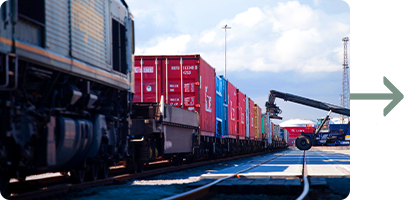Unique Logistics Solutions to Complex Container Drayage Issues
Today, more than 80% of global shipping involves containers. They're packed with everything from personal storage items in dry containers to heavy machinery on flat rack containers. For business owners shipping products, getting a container from point A to point B requires precise planning and high-level tracking. But that's easier said than done when global supply chains become over-congested, leading to loading time issues and delays.
That's bad news for business owners who are already under a massive amount of stress. The truth is that container storage delays can cripple a business, but there's a viable solution: drayage brokers in New York City, NY like RelyEx. Drayage companies provide unique solutions to minimize demurrage and help ensure the successful delivery of your freight.
With more than 30 combined years of experience and a solutions-oriented team, RelyEx has quickly become the first choice for streamlined, efficient drayage services. To understand the true value of RelyEx's offerings in the global logistics industry, it helps to understand first what drayage is and why it's used.
What is Drayage and Why Is It Important?
If you're a seasoned business owner who uses port drayage to transport your products, you know exactly how important the service can be. But if you were to poll a group of random people, you may get five different definitions of the term "drayage." That begs the question, how is one of the most crucial steps in the supply chain and most vital components of global trade such a confusing concept? When you break it down, it's not too difficult to grasp.
Drayage, by definition, means the transportation of freight from an ocean port to another destination. Today, drayage is also used to describe the process of transporting products and goods over short distances or over "the first mile."
While drayage often means short-distance movements during the supply chain process, it's primarily used in the container shipping space. Drayage loads usually have arrival and departure points in the same city and don't include long-haul, national transportation.
Let us know how we can help.
drayage broker Services
Service Areas
Because a drayage load can mean a few different things, confusion among carriers is common. Many carriers link drayage with going into a port, but that isn't always true. While all drayage loads typically originate from a port of entry, there are often several legs of a drayage journey before a container turns up at its final stop. Legs of a drayage load may include:
Why Are Drayage Companies in New York City, NY So Important?
You may be thinking, what's so important about drayage? It's such a small step in the container storage transport process. In reality, it's an integral piece needed in the logistics industry and a crucial part of U.S. supply chain management.
To truly understand the importance of drayage, let's use flowers as an example. Most cut flower shipments enter the market from areas in South America until they end up at Dutch auction houses. Once there, wholesalers purchase flowers in bulk and send those products to retail outlets worldwide. Because flowers are perishable, they typically need to be refrigerated and are often shipped in reefer containers. These refrigerated vessels must maintain a certain temp to prevent loss.
Drayage companies like RelyEx allow flower shippers to send their products from Argentinian ports to airports in the Netherlands with peace of mind because their products are protected. The only way to accomplish this feat is with the help of swift, meticulous port drayage services. Drayage companies allow flower shippers to send their products from Argentinian ports to airports in the Netherlands with peace of mind, because their products are protected. The only way to accomplish this feat is with the help of swift, meticulous port drayage services.
If port drayage is compromised, it can cause delays and even fines. You know the packages you get delivered to your front door from apps like Amazon? Without drayage and drayage brokers, one or two-day shipping times wouldn't even be possible.
As a multi-billion-dollar industry in the U.S. alone, it seems like drayage shipping issues shouldn't exist. But the fact is inefficiencies and congestion are still major problems at ports. Whether it's a lack of carriers, absent chassis, or overburdened terminals, delays lead to missed deadlines, lost revenue, and worse.
But anytime challenges exist, so too do innovative solutions.
QUOTE REQUEST
Port

Yard

Warehouse

Rail

The RelyEx Difference
RelyEx was created because our founders saw a need in the logistics space for more reliability and efficiency. The reality of the shipping and logistics industry is that it has become very transactional. It's an odd evolution, because most businesses seek a third-party logistics partner that is accessible, transparent, and committed to providing solutions.
As the logistics space continues to grow, it creates newfound expenses and complexities. Clients like ours know that and need a supply chain partner who is genuinely interested in their business. By understanding the needs of our customers and carriers, we can provide the most reliable, effective drayage services possible.
Unlike some drayage companies in New York City, NY, we begin managing your containers before they ever hit the ports by mapping out the most efficient pathways of delivery. That way, our team can discover the best drayage pathways to expedite delivery time and reduce fees that cut into profits.
Our valued drayage customers choose RelyEx because:

RelyEx Solves Problems
At RelyEx, we like to consider ourselves problem solvers. The nature of the container drayage industry presents new challenges every day, but we're firm believers that there's a solution to every hurdle we encounter. And while some drayage businesses implement a reactive approach, RelyEx customers choose us for our proactive mindset. We take pride in solving your company's drayage challenges to help you avoid frustrating fees, missed expectations, and delayed shipments. We strive to make every transaction successful and streamlined by partnering with shippers who prioritize transparent, prompt, and accurate communication.

RelyEx Has a Unique Vantage Point
RelyEx approaches your business from the customer's perspective - a unique approach that helps us provide high-quality, effective drayage services. We've been in the customers' shoes, know their pain points, and because of that, provide first-hand solutions to stressful supply chain issues. With over 30 years of collective knowledge, our team excels in:
- Inventory Management
- Logistics
- Purchasing
- Finance
Our varied, high-level drayage shipping experience helps us achieve our overarching goal: expertly managing your freight movement needs. That way, you can direct your time and focus on growing the core aspects of your business while we handle the heavy lifting. Throw in proactive planning to avoid bottleneck situations and strong communication for transparent customer relations, and you can see why so many companies trust RelyEx.

RelyEx Nurtures Strong Carrier Relationships
When it comes to shipping logistics, it only takes one mistake by a mediocre worker to disrupt your business. That's why, at RelyEx, we pride ourselves on forming and nurturing relationships with carriers who match our standards of care. Our founding partner started his career transporting freight for companies as an on-demand carrier. He uses that knowledge to maximize the resources of our carriers so that our customer's expectations aren't just met - they're exceeded.
Why Choose RelyEx as Your
Drayage Company in New York City, NY?
Based in the port city of New York City, RelyEx has a keen understanding of the challenges of managing the inbound and outbound flow of containers. Our team of container drayage experts provides your business with unique solutions to nuanced shipping problems, minimizing demurrage and ensuring the successful delivery of your freight.

Customers choose RelyEx because:
- We are a reliable drayage logistics partner that manages your freight from beginning to end
- We have a rare industry vantage point with 30+ years of client-side experience
- We foster and fortify the strongest vendor relations
- We take a proactive approach to problem-solving, not a reactive approach
Let us know how we can help.
 843-885-3082
843-885-3082

Your Drayage Shipments Managed from Start to Finish
Some drayage brokers don't care how customers feel about their service as long as they sign a contract and get paid. As a solutions-oriented team, RelyEx takes the opposite approach. We're motivated by the opportunity to overachieve for our customers and to provide them with the best logistics experience possible. With professional experience as carriers and shippers ourselves, we know the roadblocks and challenges you're facing. We excel at mapping out the best plans of action to solve those problems. But that's just the start.
Our tracking experts monitor and manage every aspect of your drayage shipment from booking to delivery, 24/7. Once booked, we look for the availability of your containers hourly once they're at port. When they arrive, our team acts quickly to access your storage containers when they're available.
Plus, RelyEx ensures your company's requirements are met by the carrier during loading and delivery and provide necessary documentation as fast as possible. With real-time tracking updates and access to our customer service professionals, your team has complete visibility throughout the shipping process.
We Source Top-Notch Operators at the Best Prices
Over the years, RelyEx has built a strong network of drayage carriers, transloading locations, and container storage spaces to provide you with the best possible options to match your drayage service needs. We know that searching for quality service presents an added layer of complexity and stress to our customers. That's why we work hard to take that off your plate by connecting you with our reliable shipping partners.
With a background moving freight as an on-demand carrier, our founding partner understands how to maximize the resources and equipment of our carriers to match your needs.


We Make Transparent, Timely Communication a Priority
Like other industries, the global logistics space is complex. Mistakes will be made, and problems will happen. With those truths in mind, RelyEx has built its reputation as problem solvers. Unlike other drayage companies, we don't shy away from this industry's complexities because we take pride in solving problems. Even better, we aim to do what's needed to avoid those problems altogether.
As your logistics partner, we will provide your company with accurate, transparent, and prompt communication. If there are unexpected issues, we'll notify you immediately and will provide several options to remedy the problem. We even offer custom reporting for large clients who need at-the-moment updates and quick access to shipment documentation.
We Have Robust Project Management Experience
Why let the unpredictability of your industry dictate your success? With a background working in manufacturing, our founders are familiar with the demands of managing production schedules and sales orders. That experience makes it abundantly clear to us that every business and industry is different. If you struggle with seasonal surges or other factors, our team supports your business with a mapped-out plan and schedule, so you stay ahead of the game.
QUOTE REQUEST
How to Avoid
Demurrage Fees for Your Business
Based in the port city of New York City, RelyEx has a keen understanding of the challenges of managing the inbound and outbound flow of containers. Our team of container drayage experts provides your business with unique solutions to nuanced shipping problems, minimizing demurrage and ensuring the successful delivery of your freight.
What is shipping demurrage?
Demurrage is a charge issued by a port, carrier, or railroad company for storing containers that do not load and unload their cargo promptly. Once the daily limit of free time is exceeded, shippers are charged daily demurrage fees until their cargo is shipped. Though different ports have different policies, charges can range from $75 to $150 per container, per day, for a set number of days. Additional demurrage fees are incurred if a shipper exceeds the port's parameters.

What causes demurrage charges?
Even when shippers maintain a tight schedule for unloading freight, external factors can play an uncontrollable part. Typically, shipping mistakes caused by human error trigger the most demurrage charges. Some of the most common causes of demurrage include:
- Paperwork Errors
- Payment Delays
- Documents Received Too Late

Paperwork Errors
Typically, shippers need four specific documents to clear shipments through customs: A Bill of Lading (or BOL), a commercial invoice, a packing list, and an arrival notice. Seasoned drayage brokers like RelyEx are used to preparing these documents, but new shippers tend to miss this step due to inexperience.
Payment Delays
If a shipper only pays for part of their shipment, a vessel operator may refuse to release their freight until their bill is fully paid. Payment delays lead to cargo detention at the port of entry, which triggers demurrage charges.
QUOTE REQUESTDocuments Received Too Late
Paperwork is needed when you're shipping goods with a drayage company. When documents like the Certificate of Origin or Bill of Lading arrive at their destination late, you can expect demurrage fees. RelyEx avoids this situation entirely by being proactive when submitting paperwork.
Additional causes for demurrage fees can include:
- Damaged Container Storage
- Custom Released Containers
- Storage Containers Are Too Heavy
Free Consultation
RelyEx:
The Supply Chain Partner You Can Count On
At RelyEx, we know first-hand how stressful supply chain problems can be for business owners. Though drayage shipping might seem minor on the surface, it affects every stage of your shipping process. And when inevitable hurdles manifest, RelyEx propels you over the proverbial roadblocks with a proactive mindset and a passion for challenging projects. We believe that all problems have a solution, and our unique vantage point allows us to provide first-hand solutions to customers in a wide array of industries.
When it comes to your business, don't settle for anything less than RelyEx. Contact our office today to learn more about how we make your shipping experience streamlined and stress-free.
 843-885-3082
843-885-3082
Latest News in New York City, NY
What’s the best bus to New York? We tested 5 for comfort and value.
Natalie B. Comptonhttps://www.washingtonpost.com/travel/2024/05/02/best-bus-new-york-dc-boston/
No matter how you travel between the major cities of the East Coast, the journey gets old fast. The New Jersey Turnpike is boring to drive. Amtrak prices can be outrageous. Flying looks good on paper, but you still have to figure out a ride to the a...
No matter how you travel between the major cities of the East Coast, the journey gets old fast. The New Jersey Turnpike is boring to drive. Amtrak prices can be outrageous. Flying looks good on paper, but you still have to figure out a ride to the airport; plus it comes with a bigger carbon footprint.
Then you have the bus, which can be the most affordable way to get from one Mid-Atlantic metropolis to another.
East Coast travelers have a glut of options when it comes to buses. You have your ultra-budget lines, midrange and luxury tiers. Having so many companies to choose from is convenient, but it’s also confusing. We tested five companies on trips between Washington, D.C., New York and Boston to help you decide which to take.
Pros: Affordable. Robust schedule.
Cons: Often packed. Itchy seats. Long lines to board.
Megabus is the Starbucks of the pack: ever-available and a little more expensive than it should be, but mostly acceptable.
The best case for Megabus is the volume of options. Unlike some of the other brands with one or two departures a day, you can find a Megabus between big cities like Philadelphia, New York and Baltimore at all hours. It also has the standard fixings: personal power outlets, WiFi and a bathroom.
Last November, I booked a last-minute round trip between D.C. and New York. The first leg was about $50 for a priority seat I reserved in the front row of the top level of the bus. The second leg without a seat assignment was $45. Book a few weeks in advance and you can find serious savings; similar one-way tickets could have cost me just $4.99 if I’d planned ahead.
Sitting in that front seat on the way out felt like cruising on the freeway in a spaceship or watching an Imax movie. No staring at the back of another bus seat, or feeling crammed in a little row. I learned later this seat assignment isn’t for everyone. My in-laws recently booked it and said they felt like they were sliding off the seat the whole trip.
Last word: Megabus is a trusty steed. It’s no-frills, but it’s always there for you.
Pros: Timely. Nice customer loyalty program.
Cons: Misleading website.
I booked a ride ($58, one-way) on Tripper Bus because the website promised the “epitome of luxury” with “leather captain seats.” But when I boarded my trip from Manhattan to D.C., I found no leather or luxury — just another basic bus with cloth seats. The WiFi was so bad, I could barely connect to my email to find out what went wrong.
Apparently, the company has two different bus options: standard coach and Elite. The website doesn’t make that very clear; neither does the company’s Instagram account. Its profile tagline calls itself an “Upscale Luxury coach service.” I felt part culpable, part catfished.
Last word: At the end of the day, Tripper is fine. It got me to my final destination as planned, even leaving a few minutes early once all passengers had been accounted for. The electrical outlets worked. The company also offers a buy-six-tickets-get-one-free scheme, which is nice for frequent travelers.
Pros: Luxurious and exclusive-feeling. An ocean of legroom. Reliable WiFi.
Cons: Limited schedule. Often expensive.
The Jet is a bona fide fancy bus between New York and D.C. reminiscent of the long-defunct (and much beloved) Royal Sprinter. It’s a smaller bus than your mega coach and seats only 14 passengers.
A huge selling point is the seats. They’re 22 inches wide — 5 inches wider than some airline seats — and made with a gel-foam base and a memory-foam back. They recline 45 degrees, boast motion-canceling technology and have six feet of distance between rows.
When I reviewed the company after it debuted in 2021, they offered lots of free perks onboard, from coffee to snacks. One-way fares were just $99. Now it’s usually closer to $200 — rivaling prices of Amtrak or flying — and you have to pay for coffee and snacks (although alcohol remains free for up to two drinks). I recently bought a one-way ticket for my fiancé, Dan, for $155, including tax, but have seen fares as low as $89.
While the motion-canceling seats are very comfortable, Dan did comment that his most recent driver accelerated and braked so aggressively that it did not feel like a smooth ride.
Last word: If your budget allows for a more expensive ticket than the typical bus, the Jet does feel like a special treat.
Pros: Prompt. Cheap. Skilled driver. Clean bathroom.
Cons: Old bus. Old seats. Less privacy.
For $38, I took a Boston to New York trip on a Peter Pan bus; fares start at just $14 for the same route if you book them further in advance, according to the website. So it was no surprise that the bus was old, from its exterior paint job to the cloth seats. It claimed to have WiFi (it didn’t work for me) but it did have functioning electric outlets.
My favorite part of the Peter Pan experience was that the driver was a seasoned professional who seemed like he had a lifetime of experience; you could tell by the way he breezed through his intro spiel — “please be nice,” and don’t make calls on speakerphone — “that is just obnoxious.” He moved the big old vehicle through traffic like butter.
The company does offer a perks rewards program to encourage repeat customers.
Last word: Peter Pan isn’t worth going out of your way to book, but if you need a ride in a pinch, it’ll do.
Pros: Quiet. Clean. Thoughtful touches. Friendly service.
Cons: Bumpy ride. Spotty WiFi.
Vamoose Bus offers an economy version and a business class. In early April, I took the more expensive ($83 one-way) Vamoose Gold Bus to New York from Bethesda, Md. — an affluent Washington suburb — on the recommendation of a colleague. As a D.C. resident, it wasn’t ideal to Uber almost a half-hour north to catch the bus, but for me that was only 10 minutes longer than driving to Union Station, where the other buses depart. The company also leaves from Arlington, Va.
There was helpful signage at the departure location and an attendant handing out complimentary full-sized water bottles for customers.
I boarded the sleek black beauty to discover a pristine interior, plush leather and lots of open seats. My fellow passengers took some work calls but maintained a courteous volume throughout the trip. The bus was bouncier than you’d expect from its appearance; I switched seats mid-trip and found a seat closer to the back that somehow felt a little smoother. Worse, the WiFi was not dependable for a service marketed toward business travelers. Sometimes it had speeds capable of uploading a high-res file; sometimes it was so bad I couldn’t open an email.
Last word: Overall, Vamoose Gold was my favorite. It was nice enough to justify the price difference between Megabus but isn’t as expensive as the Jet.
Our favorite destinations: These 12 destinations are at the top of our wish list for where to go this year, without crowds. In 2023, we explored an Alaskan bear paradise, Brooklyn’s famous pizzerias and a hidden gem in Italy, among other highlights.
Travel like a local: Residents share their favorite places in our top city guides: New Orleans, Rome, Tokyo and Mexico City.
National parks: This comprehensive guide has details on all 63 U.S. national parks. For a deep dive into five of the most well-known, you can listen to the Field Trip podcast. Then explore tips from locals for visiting Yosemite, Glacier and Everglades.
Tales from the road: Dolly Parton has opened a new resort at her theme park complex in Tennessee, while “Fixer Upper” stars Chip and Joanna Gaines have a new hotel in Waco. Road-trippers may be just as excited to see the cartoon beaver at Buc-ee’s, and bargain-hunters should consider a stop at the Unclaimed Baggage store in Scottsboro, Ala.
Portland's ice cream maker Salt & Straw slated to open two new locations on the east coast
kgw.comhttps://www.kgw.com/article/news/local/portlands-ice-cream-maker-salt-straw-locations-new-york/283-ebcca947-0877-4059-9bff-abb0d75fa9a0
The Portland based ice cream company is headed to New York City with its first scoop shops opening before the end of this summer.NEW YORK STATE, USA — Portland ...
The Portland based ice cream company is headed to New York City with its first scoop shops opening before the end of this summer.
NEW YORK STATE, USA — Portland ice cream maker Salt & Straw is headed to New York City with its first scoop shops opening before the end of this summer.
One shop is slated for 540 Hudson St. in the West Village and the other is 360 Amsterdam Ave. on the Upper West Side. Both are corner locations that have been carefully scouted to ensure that the shops fulfill the company’s vision: to be community gathering places.
“I’ve been looking (for the right New York location) for about six years, and that’s not an exaggeration,” said co-founder and CEO Kim Malek.
Part of that work has been carefully building relationships with artisans, farmers, chefs and the broader community so that when the right location is available, a shop can open and it can immediately become part of the neighborhood tapestry.
RELATED: Salt & Straw collaborates with Taco Bell on new ice cream treat
“Tyler, my cousin who started the company with me, he and I are usually on the ground for years and years getting to know other local business people, artisans, makers and that will eventually lead to the right opportunity presenting itself,” she said of how new markets are selected. She added that the work to open new shops is a “combination of art and science.”
Salt & Straw has held various pop-up events in New York over the years and each has been a success. One of the company’s investors, Danny Meyer, who founded Shake Shack (NYSE: SHAK), is also based in New York which is another tie to the city.
The Portland Business Journal, a KGW News partner, has more on the New York strategy here.
Follow KGW on social media: Facebook | Twitter | Instagram | YouTube
Download the KGW News app: Download for iPhone here | Download for Android here
Stream newscasts for free on KGW+ on Roku, Amazon Fire and Apple TV: How to add app to your device here
2024 Stanley Cup Playoffs: Rangers vs. Hurricanes Eastern 2nd Round preview
nhl.comhttps://www.nhl.com/news/ny-rangers-vs-carolina-2024-playoff-preview
The second round of the Stanley Cup Playoffs will feature the eight teams that advance out of the first round in four best-of-7 series. Today, NHL.com previews the Eastern Conference Second Round between the New York Rangers and Carolina Hurricanes.(1M) New York Rangers vs. (2M) Carolina HurricanesRangers: 55-23-4, 114 points; defeated Washington Capitals 4-0 in the first roundHurricanes: 52-23-7, 111 points; defeated New York Islanders 4-1 in the first roundSea...
The second round of the Stanley Cup Playoffs will feature the eight teams that advance out of the first round in four best-of-7 series. Today, NHL.com previews the Eastern Conference Second Round between the New York Rangers and Carolina Hurricanes.
(1M) New York Rangers vs. (2M) Carolina Hurricanes
Rangers: 55-23-4, 114 points; defeated Washington Capitals 4-0 in the first round
Hurricanes: 52-23-7, 111 points; defeated New York Islanders 4-1 in the first round
Season series: NYR 2-1-0, CAR 1-2-0
Game 1: Sunday, 4 p.m. ET (ESPN)
The New York Rangers and Carolina Hurricanes will meet in the Eastern Conference Second Round for the second time in three seasons.
The Rangers won a seven-game series against the Hurricanes in the 2022 second round to advance to the Eastern Conference Final, where they lost in six games to the Tampa Bay Lightning.
"Two years ago, we built that confidence of knowing that we can play, we can play in Carolina," Rangers defenseman Jacob Trouba said. "I just think historically we've played them decently. I think we'll be ready to go. It's going to be a fast game. I don't think either team is a whole lot different; it's two top teams in the League."
Many of the players who were part of that series are expected to be a part of this one, including Vincent Trocheck. He was New York's leading goal scorer in the first round (three goals), but in 2022, Trocheck was playing for the Hurricanes, scoring three goals against the Rangers.
"That's a big piece," Trouba said.
The Hurricanes will be trying to reach the Eastern Conference Final for the second year in a row and third time since 2019.
They got to the second round by defeating the New York Islanders in five games, including a series-clinching 6-3 win at PNC Arena on Tuesday. They had 12 different goal scorers in the first round.
Carolina was swept by the Florida Panthers in the conference final last year, scoring six goals. But this year, the Hurricanes have a more dynamic offense with the additions of Jake Guentzel and Evgeny Kuznetsov, who were acquired before the 2024 NHL Trade deadline, and Andrei Svechnikov, who was injured and didn't play in the playoffs last year.
Svechnikov had five points (one goal, four assists), and Guentzel (one goal, three assists) and Kuznetsov (two goals, two assists) each had four points in the first round.
"Whenever you can acquire two guys that are playoff proven and know when to show up in big games, it's a big boost to your team, having guys like 'Guentz' and 'Kuzy'," Carolina forward Seth Jarvis said. "Just overall, having 'Svechy' back in the lineup, I think that's what we missed a lot last year. Just three guys like that that are so dynamic, guys that thrive in the big moments and have fun, is huge for our team, huge for our locker room."
The Rangers got to the second round after sweeping the Washington Capitals in the first round, their first 4-0 playoff series win since 2007. They had 10 different goal scorers in the four games.
"I think that's going to be huge for us and it has been huge and we noticed that [against Washington]," Rangers center Mika Zibanejad said. "We have four good lines that can play against any other opponent's lines and do a good job defensively and offensively."
New York has home-ice advantage after finishing first in the Metropolitan Division and winning the Presidents' Trophy in the regular season, leading the NHL with 114 points and 55 wins, both single-season team records.
The Hurricanes were second in the Metropolitan, three points behind the Rangers.
The Rangers won two of the three regular-season games against Carolina, 2-1 at Madison Square Garden on Nov. 2 and 1-0 at PNC Arena on March 12. The Hurricanes won 6-1 at the Garden on Jan. 2.
"The Rangers are the best team in the League, right?" Carolina coach Rod Brind'Amour said. "So, we know what they're all about. They've got immense talent, coached really well and good goaltending. What don't they have? We know it's going to be a tough matchup."
The coaches in this series provide an interesting subplot. They share their greatest moment in hockey; Laviolette was the Hurricanes coach in 2006, when they won the Stanley Cup with Brind'Amour as their captain.
"There's got to be some timeframe or expiration date on what you're asking, a statute of limitations," Laviolette said jokingly when asked if his history with Brind'Amour makes this series different. "I think it's like 12 years and I'm on the flip side of that, so this is just a series."
‘Presentation is Everything’: Inside the World of Art Fair Booth Design
Liz Robbinshttps://www.nytimes.com/2024/05/02/arts/design/tefaf-new-york-booths-fair.html
Before 89 international art dealers showcase their exquisite wares inside a building that was once the playground for New York’s rich and famous, they get the chance to be children again.Their grown-up game? Designing strikingly unique booths out of tight uniform spaces for TEFAF New York, the European Fine Art Foundation fair at the Park Avenue Armory.Some dealers still play with foam core m...
Before 89 international art dealers showcase their exquisite wares inside a building that was once the playground for New York’s rich and famous, they get the chance to be children again.
Their grown-up game? Designing strikingly unique booths out of tight uniform spaces for TEFAF New York, the European Fine Art Foundation fair at the Park Avenue Armory.
Some dealers still play with foam core models that resemble dollhouses. Others — those blessed with warehouse space — can create life-size replicas before shipping the pieces. Most in this digital age, however, tinker collaboratively inside 3-D digital structures as if they are playing video games.
Welcome to the passionately precise world of art fair design, where for gallery directors, no detail is too trivial, and every millimeter matters.
“Designing booths is one of my favorite things to do,” Evan Snyderman, a co-founder of R & Company gallery in New York, said gleefully. “It’s always been something I’ve done and to the point of almost driving my wife crazy because I’m constantly rearranging the house, moving things like one inch to the left.”
The son of Philadelphia gallery owners, Snyderman said he was already arranging his Matchbox cars in diagonal rows at 8 years old. He also placed his hand puppets on wall-mounted boxes and ordered his collection of daggers and pocketknives just so.
Now, he and his partners do it for a living.
“Like we learn in art school, presentation is everything,” said R & Company’s co-founder Zesty Meyers.
If nothing else, dealers take on TEFAF New York booths as a personal challenge.
“Honestly,” said the eponymous owner of Sean Kelly Gallery, “we all do more than enough art fairs and so one of the things that we’re always looking for is a way to kind of amuse ourselves and keep it fresh.”
More on TEFAF New York
About three months before the May fair, TEFAF officials email dealers booth and room assignments, and a menu of design options. Galleries choose the fabric color to cover the walls of the booths that sit under the cavernous ceiling. They also choose types of flooring, paint, electrical outlets, track lighting and temporary office furniture like storage cabinets.
The booths in the armory’s drill hall range in size from 20 square meters to 49 square meters (about 215 square feet to 527 square feet; TEFAF only provides metric measurements to its dealers). The period rooms, including three downstairs and 12 upstairs, range from about 355 to 656 square feet.
Galleries are strictly forbidden to do anything to alter these rooms that were once clubhouses for the companies belonging to the Seventh Regiment of the Armory on Park Avenue.
R & Company, which showcases historical and contemporary design, had always been tucked into the same back left corner of the drill hall until this year, when it moved upstairs. At first, Snyderman wanted to lighten the dark mahogany room equipped with 19th-century swords, shields and iron chandeliers.
Plans to hang a Katie Stout chandelier were rejected because it weighed more than 100 pounds. Although Snyderman decided to keep the interior of the room visible, he built a free-standing trellis for track lighting.
Snyderman worked twice a week together with his architect in computer sessions, starting with an anchor piece at the back of the room: a rare nearly seven-foot-tall Wendell Castle stack-laminated oak cabinet.
To draw viewers’ eyes to it, the pair created a 12-foot wall that partly blocked the windows behind it and would serve as a stage. They chose to paint it “quetzal,” a rich aqua color that serves as a uniting element for the room’s other pedestals. In their model, they incorporated Castle’s models for the sculpture, which will also be on display.
“That’s a big part of the design for us, the storytelling,” Snyderman said. He and his team went through at least six iterations of design layouts to place the other pieces in visual harmony, including a tomato red Lina Bo Bardi “Bowl Chair,” vessels by Roberto Lugo, and an Isamu Noguchi table, stool and lamp.
Kasmin Gallery, also in an upstairs period room, chose for its anchor piece Alma Allen’s 190-pound bronze moth. That needed to be reinforced onto one of the temporary walls — painted dark gray — that the dealers built inside the existing walls.
During a visit in April to the gallery in Chelsea, a smaller version of the moth was already affixed diagonally to the foam core walls of the scale model, 31 inches by 16.5 inches by 14 inches. Edith Dicconson, a co-executive director of the gallery, delighted in trying different arrangements for a Robert Motherwell painting (reduced in scale to the size of a postage stamp) and a 3-D Max Ernst sculpture.
“We come in here and all of our heads can look in like this and collaborate,” she said, adding with a kidlike cackle, “Isn’t it fun?”
Kasmin’s goal is to create an elegant but accessible space, where the works of artists who were friends and collectors of each other’s work — like William N. Copley and Les Lalanne — can be in dialogue.
What might they be whispering?
“I think they would have conversations about the style in which they would work,” said Mariska Nietzman, a Kasmin co-executive director. “But I think they also would perhaps just have cups of coffee and glasses of wine.”
Boris Vervoordt of Axel Vervoordt gallery was much more serious in discussing his digitally rendered booth, which allowed his staff across multiple time zones to try different combinations during video calls.
His gallery has occupied the same upstairs period room at the fair for about four years, in part because TEFAF respects his zero-waste policy. Recycling the same structure makes it easier to substitute new works of art, like a rarely shown 1993 painting by Kazuo Shiraga in this year’s booth.
Instead of the same space, Andrew Duncanson of Modernity gallery in Stockholm, which specializes in 20th-century Nordic furniture, lighting and jewelry, chose to move from last year’s upstairs quiet period room to the crowded drill hall.
This year, he built a mock-up of the booth in his warehouse, featuring a Carl Malmsten daybed and a showstopper of a chandelier, “Snowflake” by Paavo Tynell.
“We want to create an ambience in the room where it feels like you can move right in,” he said.
Duncanson created that atmosphere so well last year that TEFAF New York’s director, Leanne Jagtiani, said she warned him, “Don’t be surprised if you come in one morning and I’m here because I stayed overnight.”
Duncanson said that last year, TEFAF committee members told him his room design earned him an A+, even though Jagtiani said the design commendations were given in verbal rather than report card form.
For dealers, the sales ledgers are what ultimately matter.
This year, Sean Kelly will also set up in the drill hall, moving into a larger, back corner spot. It came, however, with a caveat: an immovable diagonal support wall. So Kelly and his crew made it into a room divider for three distinct views and a funnel for foot traffic.
At one entrance, a cast iron statue by Antony Gormley welcomes visitors. The anchor pieces will be any one of three large-scale works by the German photographer Candida Höfer and two paintings by the British artist Idris Khan.
A month before TEFAF, Terrill Warrenburg, art fair and special project manager at Sean Kelly Gallery, was still swapping options on the computer to see how their shapes, colors and themes interacted with one another. They also had to account for the possibility that a work could sell right before TEFAF opens, taking it off the roster.
“It is a bit like four-dimensional chess because you have all these options and you build around them and they have to play nicely together — and you keep going until you feel like you got something that clicks,” Kelly said.
He laughed, adding, “And then, inevitably, you get there and then you change it all around.”
State Your Case: Rangers or Hurricanes in Eastern 2nd round of playoffs
nhl.comhttps://www.nhl.com/news/who-will-win-new-york-or-carolina-nhl-playoffs-east-2nd-round
The New York Rangers will face the Carolina Hurricanes in the Eastern Conference Second Round of the 2024 Stanley Cup Playoffs.The Rangers, the top seed in the East and the winner of the Presidents' Trophy as the team with the most points during the regular season, swept the Washington Capitals in the first round.The Hurricanes, who finished three points behind the Rangers in the Metropolitan Division, defeated the New York Islanders in five games in the first round.Game 1 of the best-of-7 series will be at Madison Squar...
The New York Rangers will face the Carolina Hurricanes in the Eastern Conference Second Round of the 2024 Stanley Cup Playoffs.
The Rangers, the top seed in the East and the winner of the Presidents' Trophy as the team with the most points during the regular season, swept the Washington Capitals in the first round.
The Hurricanes, who finished three points behind the Rangers in the Metropolitan Division, defeated the New York Islanders in five games in the first round.
Game 1 of the best-of-7 series will be at Madison Square Garden. The date and time has not yet been announced.
The Rangers were 2-1-0 against the Hurricanes during the regular season. New York won 2-1 on Nov. 2 and 1-0 on March 12, and lost 6-1 on Jan. 2.
New York and Carolina have faced each other twice in the playoffs; the Rangers defeated the Hurricanes in seven games in the second round in 2022, and the Hurricanes swept the Rangers in the best-of-5 Stanley Cup Qualifiers in 2020.
Who will win this series? That's the question before senior writer Dan Rosen and senior director of editorial Shawn P. Roarke in this playoff edition of State Your Case.
Roarke: The margins are super slim here. Across an 82-game season, these two teams were separated by three points. Each has game-breaking forwards, elite defensemen and a world-class starting goalie. Oh yeah, the coaches -- Peter Laviolette for the Rangers and Rod Brind'Amour for the Hurricanes -- aren't bad, either. So, what's going to be the difference between these two behemoths? Like it usually is at this time of the season, it'll be the little things. It is will over skill when the calendar turns to May and beyond, and there are few teams that do the little things as well as the Hurricanes. They are relentless on the forecheck, aggressive on the penalty kill, opportunistic on the power play and punishing in their own end. Even their stars are willing to put their work boots on to get the job done. The Hurricanes roll their four lines with minimal regard to matchups and count on their depth and discipline to be the difference. It was in the first round and it will be again this time.
Rosen: Shawn is right about a lot. I can't disagree with anything he said about the margins being slim and the similarities between these two teams. I'll add special teams to that, too. The Hurricanes were second on the power play and first on the penalty kill during the regular season and the Rangers third in each. And I'll agree with that Carolina does the little things well too. But so does New York, which has more skill, which will matter in this series because maybe for the first time since Rod Brind'Amour took over as Hurricanes coach in 2018-19, these two teams are equal in will. They weren't two years ago and still the Rangers won the series in seven games, their skill winning out in a 6-2 Game 7 win. In this series, they have the most skilled player in forward Artemi Panarin and the most skilled defenseman in Adam Fox. They may have the most skilled forward line with Vincent Trocheck centering Panarin and Alexis Lafrenière. Each teams is deep. Each is coached well. Each has excellent goaltending. Each has elite special teams. The Rangers have more skill. It will make the difference.
Roarke: Jeez, I guess I should quit. Rosen is too good, like the Rangers he describes. Forget that. I never quit. Neither do these Hurricanes. Nothing rattles them. With the team Dan described, you'd think they would be world-beaters, but they were three points better than Carolina in the regular season and didn’t pull away until the final week of the season. In the three head-to-head matchups in the regular season, the Rangers scored four goals. Big whoop! They scored 278 goals during the regular season, but only 167 came during 5-on-5 play. They had 15 goals in four games during the first round; just eight during 5-on-5. All the Hurricanes want to do is play 5-on-5. Not only is their penalty kill the best in the business but Carolina doesn’t rely on it. They allowed 146 goals during 5-on-5 play, sixth fewest during the regular season. In the postseason, the Hurricanes have taken 11 penalties in five games and have been short an average of 3:38 per game. Nobody has been shorthanded more than the Rangers (7:18). New York will play this series mostly at 5-on-5, and that doesn't favor Dan’s overly generous estimation of the talent disparity that might exist.
Rosen: Here's the thing, Shawn -- the Rangers are not going to be fearful of the Hurricanes power play. In fact, Carolina might want to worry about New York's penalty kill, because it can be explosive offensively too. That's another way the Rangers are going to find a way to beat the Hurricanes. They'll kill the penalties, but they'll be dangerous offensively when they do with Trocheck, center Mika Zibanejad and forward Chris Kreider on the kill. New York scored two short-handed goals against Washington, and more opportunities off 2-on-1s that didn't connect. But the other aspect of this, and it is maybe the most important, is the Rangers do have the edge in goaltending. Igor Shesterkin is money in the bank. He has been since taking a mini-break after participating in All-Star Weekend. He allowed seven goals on 101 shots in the first round against the Capitals, a .931 save percentage. Frederik Andersen was good against the Islanders, but he allowed three goals three times. If he gives up three against the Rangers, against Shesterkin, there's a better chance of losing than winning. Andersen is also prone to injury; he didn't play in the second round against the Rangers two years ago because of that. Shesterkin is stable and reliable. I'll take him. I'll take the Rangers.
Disclaimer:


